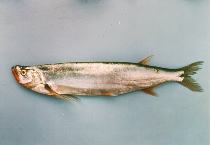| Family: |
Xenocyprididae (East Asian minnows) |
| Max. size: |
100 cm TL (male/unsexed) |
| Environment: |
benthopelagic; freshwater |
| Distribution: |
Asia: Thailand to Viet Nam and Indonesia (Ref. 7050). Known from the Mekong and Chao Phraya basins (Ref. 26580). |
| Diagnosis: |
Dorsal soft rays (total): 10-10; Anal soft rays: 25-27. Head upturned; no barbels; belly with sharp keel from throat to anus (Ref. 43281). Body strongly compressed; dorsal profile flat except concave nape. Mouth directed upward. Pectoral fins elongated. Base of caudal fin with black blotch (Ref. 4792). Lower jaw protruded, tip of it hooked and inlaid into gap of upper jaw; scales minute and irregularly arranged (Ref. 45563). |
| Biology: |
Found in large rivers and lakes at medium to shallow depths. Juveniles feed on insects while adults on fish (Ref. 12693). Move towards the flooded forest when the water is high and returns to the river as soon as the water level starts to subside (Ref. 12693). Good flesh but fairly soft and with numerous bones. In Laos, it is usually grilled, simmered with padek and made into Ponne pa. Usually marketed fresh and probably exported to Thailand (Ref. 12693). Widely distributed but greatly reduced in numbers probably throughout its range. Extremely sensitive to gillnetting and perhaps also to pollution (Ref. 12369). |
| IUCN Red List Status: |
Least Concern (LC); Date assessed: 31 January 2019 Ref. (130435)
|
| Threat to humans: |
harmless |
Source and more info: www.fishbase.org. For personal, classroom, and other internal use only. Not for publication.

